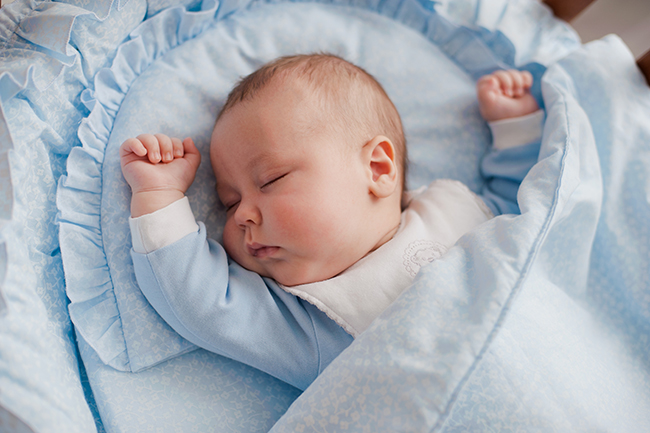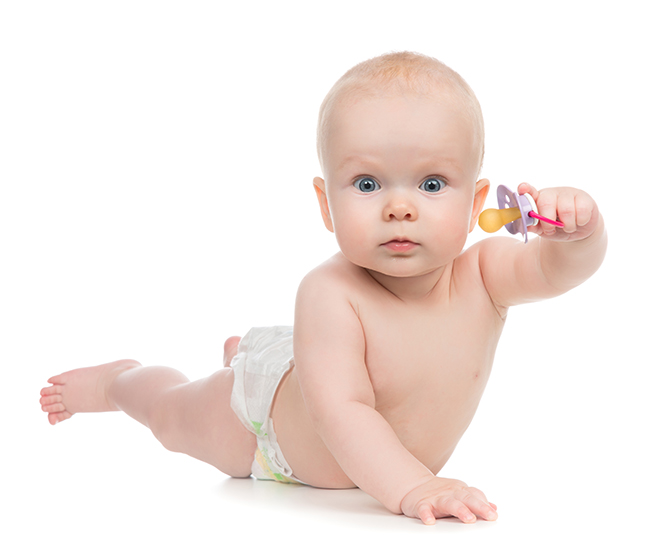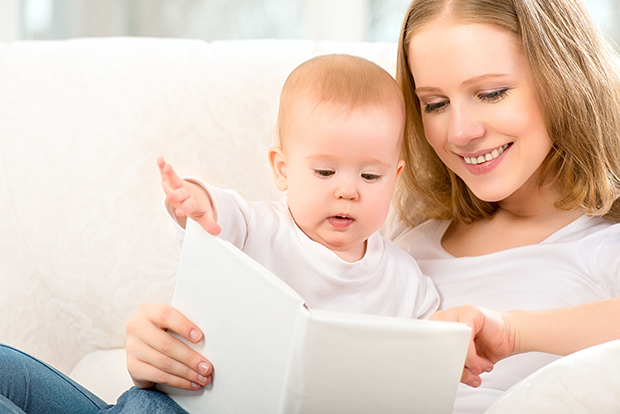Safe Sleep for Your Baby
July 21, 2017

Safe Sleep for Your Baby
Sleep position. Type of crib. Location of crib. Room temperature. Pacifiers.
Whether you are a new or veteran parent, there’s one thing to know about getting your baby to sleep safely: the rules are always changing. So even if you’ve experienced the joy of a newborn a time or two before, it’s best to check the latest information on safety and infant sleep.
Here are some common questions with their correct answers — as well as incorrect or out-of-date assumptions that you should be aware of. Anyone involved in the care of your infant, from family members to baby sitters, should be informed as well.
What position should my baby sleep in?
According to the American Academy of Pediatrics (AAP), you should always place your newborn on his or her back. “Putting your infant in this position,” says Eva M. Mayer, MD, pediatrician, St. Luke’s Coopersburg Pediatrics, “has been shown to reduce the risk of Sudden Infant Death Syndrome (SIDS) by over fifty percent.” The reasons for this aren’t clear — it could be that babies positioned on their stomachs get less oxygen or expel less carbon dioxide because they are rebreathing the air directly around them — but the statistics prove: place your baby on her back to sleep. Don’t rely on commercially marketed devices that promise to reduce the risk of SIDS; these are not proven.

If your child has gastro esophageal reflux (GERD), the AAP still recommends the back sleeping position; but for this and other conditions, check in with your pediatrician just to be sure, advises Dr. Mayer.
Note: For muscle development, stomach time is important. Supervised tummy positions during awake hours give your child the time she needs to develop the neck and shoulder muscles she uses to raise her head; positioning your child on his stomach while he’s awake and you’re watching also helps to prevent flat head syndrome.
We’re planning to reuse the crib we have from our first child. That’s okay, right? And once I get that settled, what kinds of objects are safe to have in the crib?
Make sure that whatever crib you use complies with the latest regulations from the Consumer Product Safety Commission (CPSC). Dr. Mayer recommends checking the CPSC website for up-to-date information on safety, and to monitor its product recall list. “Cribs are no longer allowed to have drop-side rails, for example, and they need to have stronger slats and better quality hardware,” she explains. “Even if your crib is a treasured heirloom, it’s better to be safe. Though new cribs can be expensive, knowing you’re doing what you can to make sure your infant is protected is worth everything.”
When you buy a new crib, bassinet, or play yard — anything associated with nursery or baby equipment — the CPSC strongly urges you to fill out that pesky product registration card so that you will be automatically informed if any hazards are found to be associated with your purchase, or if there is a recall ordered. Your child’s safety is worth the few extra minutes it will take to fill out.
As for what’s in the crib? Basically: nothing except a firm mattress (no indentation when your baby lies down) that fits snugly into the frame and has tight, fitted sheets. Crib bumpers, blankets, stuffed animals and pillows — any kind of bedding or toys that are soft or loose — present suffocation hazards to an infant under a year old. There is no evidence that those cushiony bumpers prevent injury, and they present a risk. You can save that fun or decorative stuff for when they’re older; talk to your pediatrician about timing, suggests Dr. Mayer.
Similarly, wedges and positioners should not be used because of possible suffocation or entrapment. If your baby rolls to his side when sleeping, simply roll him back. Once your infant can roll from his back to his stomach and back again, there is no longer a need for you to reposition him.
Where should our baby sleep? Doesn’t he need to be warm and cozy at night?
The latest AAP recommendation is that your infant should sleep in your room — but not your bed. Your baby will be nearby, so it will be easy to reposition her if she rolls at night, and she will be within reach for nighttime feedings. Remember, though, that all equipment (especially cords, as from phone chargers or white noise machines) should be kept well away from the crib to prevent strangulation.
You should locate the crib, bassinet, or play yard (all up to the latest CPSC standards) in your room away from any windows or window treatments, and also away from heating or cooling elements. The temperature of your room should be kept comfortably cool; since there are no blankets in the crib, you can put your infant into a sleep sack or sleep clothing. That will keep him warm enough and will prevent overheating.
Even if your infant has a habit of falling asleep in his car seat or other sitting position, this is not recommended for regular sleep; move your child gently onto his back in his crib or bassinet.
What’s the current thinking on pacifiers?
Use them, if you can. The AAP says that evidence draws a connection between the use of a pacifier and risk reduction from SIDS. After breastfeeding is established, try offering a pacifier at naptime and bedtime. If your baby accepts it, fine; if not, you don’t need to fuss over it.

I can’t wait to read and sing my baby to sleep. When can I start?
Those kinds of nighttime rituals are soothing for infants and parents alike — a warm bath or infant massage, snuggles, a favorite book and song — but wait till your baby is sleeping for longer stretches. Once you can figure out when that longer stretch of time is, you can start your nighttime rituals a bit before that. (By this time, you may also be less sleep-deprived!) Try, if possible, to put your baby in her crib when she’s drowsy, but awake, so she can learn how to doze off by herself.

What else should I be aware of?
Dr. Mayer says that there are several basic things that every parent should know. The first is that breastfeeding is best, if possible, since it is associated with a decreased risk of SIDS. The second is: make sure your infant is immunized; evidence suggests that immunizing your baby reduces the risk of SIDS by a large percentage. “Last, but not least, do not smoke — during pregnancy or after birth. Your child’s health depends on it,” concludes Dr. Mayer.
Media Contact
Sam Kennedy, Corporate Communications Director, 484-526-4134, samuel.kennedy@sluhn.org
About St. Luke’s
Founded in 1872, St. Luke’s University Health Network (SLUHN) is a non-profit, regional, fully integrated and nationally recognized network providing services at seven hospitals and more than 270 outpatient sites. The network’s service area includes Lehigh, Northampton, Carbon, Schuylkill, Bucks, Montgomery, Berks and Monroe counties in Pennsylvania and in Warren County in New Jersey. Dedicated to advancing health education, St. Luke’s operates the nation’s oldest School of Nursing and 22 graduate medical educational programs and is considered a major teaching hospital, the only one in the region. In partnership with Temple University, St. Luke’s created the region’s first Medical School. Repeatedly, including 2017, St. Luke’s has earned Truven’s 100 Top Major Teaching Hospital designation as well as 50 Top Cardiovascular program in addition to other honors for clinical excellence. St. Luke’s is a multi-year recipient of the Most Wired award recognizing the breadth of St. Luke’s information technology applications such as electronic medical records, telehealth, online scheduling and pricing information. St. Luke’s is also recognized as one of the state’s lowest cost providers in comparison to major teaching hospitals and other health systems.
Read More NewsLatest News


December 09, 2025
Talk With Your Doctor – Vaccination Updates

November 18, 2025
Accessible and Stress-Free Wisdom Teeth Removal

October 23, 2025